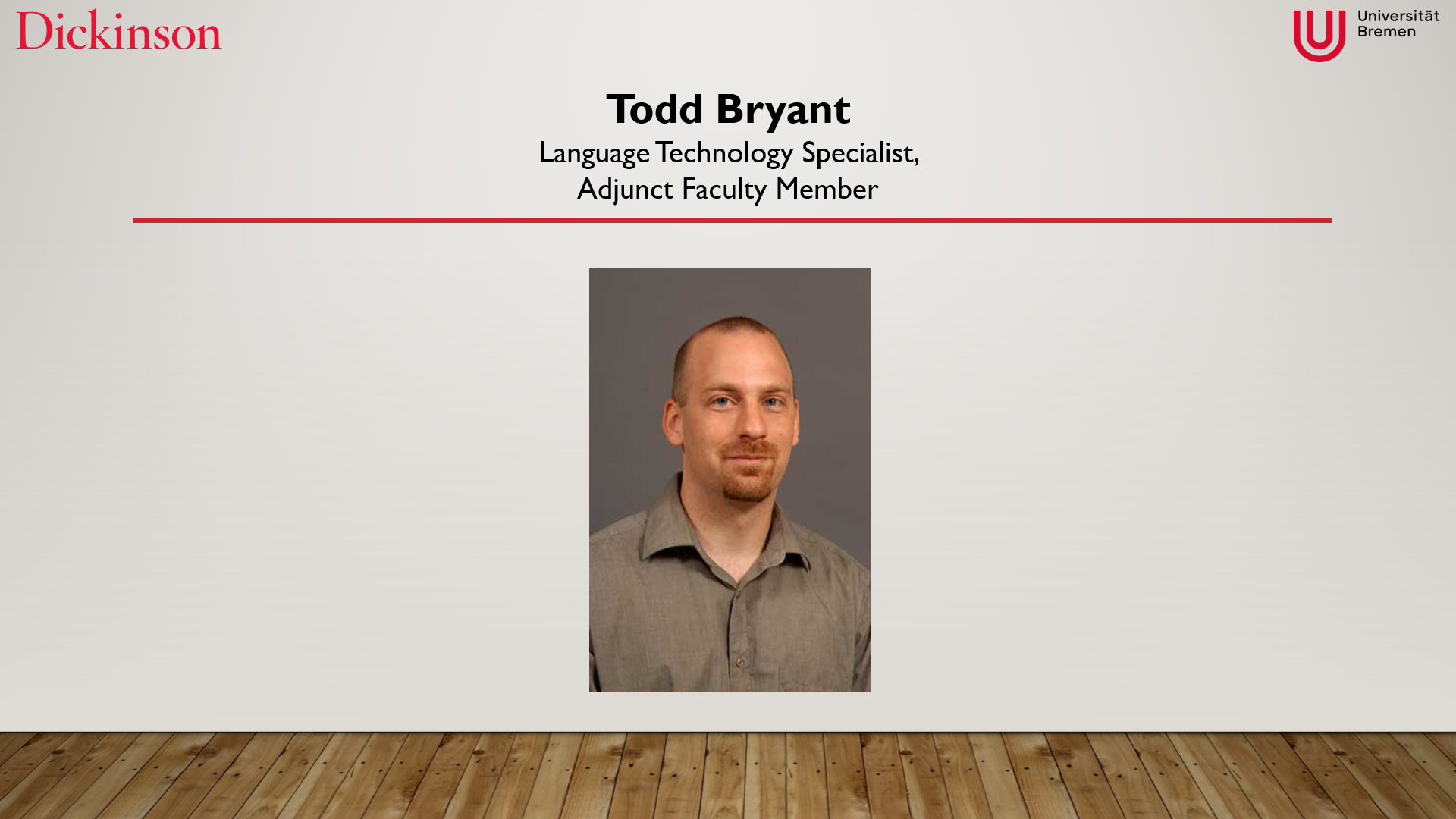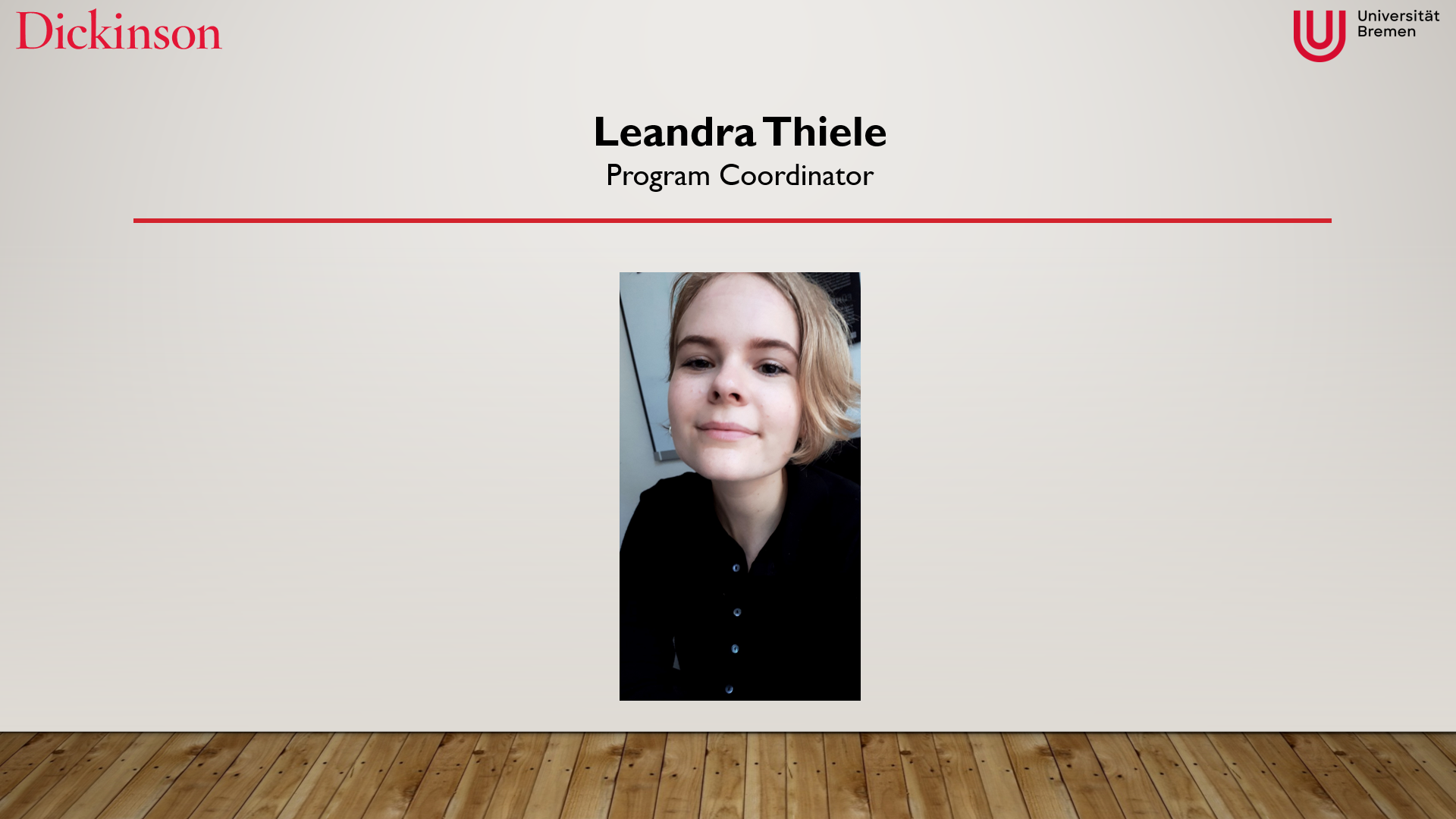 “Servus!” Prof. Haque has been teaching at Dickinson since 2008. He teaches all levels of the curriculum. Some courses he regularly teaches include Mountains in German Culture, German Literature and Film of the First World War and German Intellectual History. His research focuses on the Alps in German-language film and literature. When he is in Europe, you can find him in Munich or the mountains of Germany, Austria and Northern Italy. If he has to be somewhere flat, Bremen is a great place to be!
“Servus!” Prof. Haque has been teaching at Dickinson since 2008. He teaches all levels of the curriculum. Some courses he regularly teaches include Mountains in German Culture, German Literature and Film of the First World War and German Intellectual History. His research focuses on the Alps in German-language film and literature. When he is in Europe, you can find him in Munich or the mountains of Germany, Austria and Northern Italy. If he has to be somewhere flat, Bremen is a great place to be!
Meet the people behind the Durden Dickinson Bremen Program: Antje Pfannkuchen, Ph.D.
 Prof. Pfannkuchen arrived at Dickinson in 2009. After living in Berlin, NYC and London, Carlisle was a bit of a change, but by now (and especially during the pandemic) small-town living has grown on her. At the moment, though, she is on leave as a visiting scholar at Johns Hopkins University, finishing her manuscript “Printing the Invisible.” This book studies the beginnings of photography in the early 19th century and how they were connected to research in electricity and to romantic poetry.
Prof. Pfannkuchen arrived at Dickinson in 2009. After living in Berlin, NYC and London, Carlisle was a bit of a change, but by now (and especially during the pandemic) small-town living has grown on her. At the moment, though, she is on leave as a visiting scholar at Johns Hopkins University, finishing her manuscript “Printing the Invisible.” This book studies the beginnings of photography in the early 19th century and how they were connected to research in electricity and to romantic poetry.
Prof. Pfannkuchen came to German Studies indirectly after a first degree in “Kulturwissenschaften” (Cultural History) with a focus on media theories and a second master’s from NYU’s Interactive Telecommunications Program (ITP) exploring technological innovations. Her current work is informed by her continued interest in the media-technological state of our world. That’s why students in her courses with topics as diverse as “German-Jewish Culture,” “Goethe Forever!” or “The German Political Landscape” are taught to produce podcasts and videos, instead of merely consuming them.
Normally she is back in Germany at least twice every year with regular stays in Bremen, Berlin, and her hometown Dresden.
Meet the people behind the Durden Dickinson Bremen Program: Sarah McGaughey, Ph.D.
 Prof. McGaughey joined the German Department in 2007 and continues to appreciate being a part of creativity and interdisciplinarity of Dickinson’s liberal arts and sciences community. She enjoys teaching language, culture, and literary studies at all levels of the curriculum. Most recently, she has developed and taught courses such as German Environments, German in Performance, German Pop! and Architecture of the German-Speaking World. In her Intermediate German course, she created content on refugee history and Sturm und Drang (Storm and Stress) and changed the format of exams to focus on the skills of communication: reading, writing, and speaking. Students in her courses have created podcasts and presentations on topics such as Eurogames, Berliner club history, and 19th century nation building in German-speaking Europe. Creative student projects include a ghostly radio drama and a literary talk show modelled on Das literarische Quartett.
Prof. McGaughey joined the German Department in 2007 and continues to appreciate being a part of creativity and interdisciplinarity of Dickinson’s liberal arts and sciences community. She enjoys teaching language, culture, and literary studies at all levels of the curriculum. Most recently, she has developed and taught courses such as German Environments, German in Performance, German Pop! and Architecture of the German-Speaking World. In her Intermediate German course, she created content on refugee history and Sturm und Drang (Storm and Stress) and changed the format of exams to focus on the skills of communication: reading, writing, and speaking. Students in her courses have created podcasts and presentations on topics such as Eurogames, Berliner club history, and 19th century nation building in German-speaking Europe. Creative student projects include a ghostly radio drama and a literary talk show modelled on Das literarische Quartett.
Most of her publications, including two books, focus on the early work of the Austrian Jewish author Hermann Broch (1886-1951), in particular the role of architecture and the environment in his pre-exile literary projects. Her current research focuses on homes and gardens in the interwar period in Central Europe. An additional area of interest is now contemporary young adult literature and environmental crisis. In her spare time, she enjoys reading, walking and hiking, cooking, and listening to lots and lots of German radio. She is also an avid fan of the longest running German crime series, Tatort.
Meet the people behind the Durden Dickinson Bremen Program: Ann Hudson
 Her interest is bringing the German and French speaking worlds to the elementary levels of the Dickinson classroom. Her specialty in second language acquisition is teaching not only how to communicate in both languages, but to also make connections and comparisons between our culture and the various communities of those worlds, so that the students will one day be able to use their target language(s) globally.
Her interest is bringing the German and French speaking worlds to the elementary levels of the Dickinson classroom. Her specialty in second language acquisition is teaching not only how to communicate in both languages, but to also make connections and comparisons between our culture and the various communities of those worlds, so that the students will one day be able to use their target language(s) globally.
Meet the people behind the Durden Dickinson Bremen Program: Todd Bryant
 Todd Bryant is an adjunct faculty member in the German department and the liaison to the foreign language departments for the department of instructional media services. He focuses on bringing authentic materials into the language class room, collaborative activities in new media, and exchanges with native speakers via Skype.
Todd Bryant is an adjunct faculty member in the German department and the liaison to the foreign language departments for the department of instructional media services. He focuses on bringing authentic materials into the language class room, collaborative activities in new media, and exchanges with native speakers via Skype.
Meet the people behind the Durden Dickinson Bremen Program: Leandra Thiele
 Leandra Thiele holds a bachelor’s degree in English-Speaking Cultures and Linguistics from the University of Bremen and will soon complete her master’s degree in English-Speaking Cultures. She was an OSA (Overseas Student Assistant) in 2016-17 in the German Department at Dickinson College. For the Spring Semester 2021, she has returned to her old role as teaching assistant and is remotely teaching German 101 and 102 classes.
Leandra Thiele holds a bachelor’s degree in English-Speaking Cultures and Linguistics from the University of Bremen and will soon complete her master’s degree in English-Speaking Cultures. She was an OSA (Overseas Student Assistant) in 2016-17 in the German Department at Dickinson College. For the Spring Semester 2021, she has returned to her old role as teaching assistant and is remotely teaching German 101 and 102 classes.
Leandra is also currently replacing the Dickinson-in-Bremen program coordinator Verena Mertz and is very happy to be back on the program.
She is looking much forward to be hopefully welcoming new Dickinsonians to the Uni Bremen campus in the fall!
The Durden Dickinson Bremen Program Is Back!
Like most exchange programs, our Dickinson-in-Bremen program had to be suspended since last year due to the pandemic. But there is a silver lining on the horizon: We are planning to re-open this fall! We are more than excited to welcome the first group of Dickinsonians back in Bremen in October 2021. Currently, our staff is in full preparation to create a rich and attractive program for the winter semester. We cannot wait to meet our students in person and hopefully see those red Dickinson chairs on the campus of Uni Bremen not so lonely anymore! 🙂
Our New Spring Flyer is Here!
 To all Bremen students: Our scholarship flyer for the spring semester 2022 at Dickinson College has arrived!
To all Bremen students: Our scholarship flyer for the spring semester 2022 at Dickinson College has arrived!
On the flyer you can find all necessary information about our scholarship program between the Uni Bremen and Dickinson College.
You can download the flyer here.
Apply now to become a Dickinsonian!
Bremen was rated as the most bicycle-friendly major city!
 As reported by the Frankfurter Allgemeine newspaper, the German Federal Minister of Transport, Andreas Scheuer (CSU), awarded the most bicycle-friendly cities in Germany according to ADFC, the General German Bicycle Club. Here, Bremen leads among cities with more than 500,000 inhabitants, ahead of Hanover and Frankfurt.
As reported by the Frankfurter Allgemeine newspaper, the German Federal Minister of Transport, Andreas Scheuer (CSU), awarded the most bicycle-friendly cities in Germany according to ADFC, the General German Bicycle Club. Here, Bremen leads among cities with more than 500,000 inhabitants, ahead of Hanover and Frankfurt.
For this ninth city comparison, the bicycle club examined 27 aspects such as acceptance as a road user, public bicycles or the feeling of safety. Around 230,000 people took part in an online survey. “I want cycling to become energy, enjoyment and joie de vivre much more often again,” said Scheuer.
The full article can be found here:
Spring in Bremen!
After a couple of rough snowy winter-weeks, spring has already arrived in Bremen! If you want to see how blooming Bremen looks like during this season, you should take a look at BREMENbewegt‘s “Frühling in Bremen” video which features the city’s most beautiful places: der Bürgerpark, die Wallanlagen, der Rhododendronpark, der Marktplatz and more. Where would you like to enjoy the warming sun the most?
Source: https://www.youtube.com/watch?v=H0cRuQWKmnw&ab_channel=BREMENbewegt




